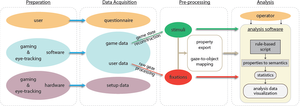Information
- Publication Type: Article in a Book
- Workgroup(s)/Project(s):
- Date: April 2013
- Booktitle: Game Analytics: Maximizing the Value of Player Data
- Editor: M. Seif El-Nasr, A. Drachen, A. Canossa, K. Isbister,
- ISBN: 9781447147688
- Publisher: Springer
- Pages: 543 – 583
- Keywords: Eye Tracking, Visual Attention, Computer Games
Abstract
This chapter presents state-of-the-art methods that tap the potential of psychophysics for the purpose of understanding game players' behavior. Studying gaze behavior in gaming environments has recently gained momentum as it affords a better understanding of gamers' visual attention. However, while knowing where users are attending in a computer game would be useful at a basic level, it does not provide insight into what users are interested in, or why. An answer to these questions can be tremendously useful to game designers, enabling them to improve gameplay, selectively increase visual fidelity, and optimize the distribution of computing resources. Furthermore, this could be useful in verifying game mechanics, improving game AI and smart positioning of advertisements within games, all being applications widely desirable across the games industry. Techniques are outlined to collect gaze data, and map fixation points back to semantic objects in a gaming environment, enabling a deeper understanding of how players interact with games.
Additional Files and Images
Additional images and videos
Additional files
Weblinks
No further information available.
BibTeX
@incollection{sundstedt-2013-vag,
title = "Visual Attention and Gaze Behaviour in Games: An
Object-Based Approach",
author = "Veronica Sundstedt and Matthias Bernhard and Efstathios
Stavrakis and Erik Reinhard and Michael Wimmer",
year = "2013",
abstract = "This chapter presents state-of-the-art methods that tap the
potential of psychophysics for the purpose of understanding
game players' behavior. Studying gaze behavior in gaming
environments has recently gained momentum as it affords a
better understanding of gamers' visual attention. However,
while knowing where users are attending in a computer game
would be useful at a basic level, it does not provide
insight into what users are interested in, or why. An answer
to these questions can be tremendously useful to game
designers, enabling them to improve gameplay, selectively
increase visual fidelity, and optimize the distribution of
computing resources. Furthermore, this could be useful in
verifying game mechanics, improving game AI and smart
positioning of advertisements within games, all being
applications widely desirable across the games industry.
Techniques are outlined to collect gaze data, and map
fixation points back to semantic objects in a gaming
environment, enabling a deeper understanding of how players
interact with games. ",
month = apr,
booktitle = "Game Analytics: Maximizing the Value of Player Data ",
editor = "M. Seif El-Nasr, A. Drachen, A. Canossa, K. Isbister,",
isbn = "9781447147688",
publisher = "Springer",
keywords = "Eye Tracking, Visual Attention, Computer Games",
URL = "https://www.cg.tuwien.ac.at/research/publications/2013/sundstedt-2013-vag/",
}



